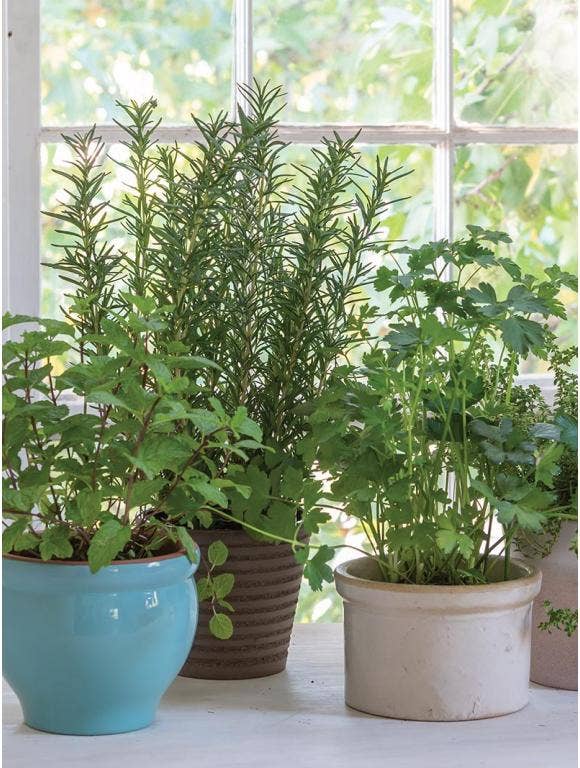


The fragrant scent of basil leaves, the color and zip of freshly snipped chives, or the citrusy notes of lemon balm in a glass of iced tea can be among the best sensory gifts of summer gardens. Fortunately, you don't have to give up those seasonal pleasures if you know how to bring in herbs for the winter.
By bringing in herbs over the winter, you can easily level up your winter menu when you sit down to a bowl of pasta with fresh oregano, sip a hot mug of tea with lemon verbena and mint, and sprinkle chopped fresh thyme, rosemary and garlic chives onto a roast or into a steaming stockpot of soup. Even better: If you learn how to keep herbs over winter, you won't have to buy replacement plants or start annual herbs from seed when spring returns.
Evaluate Your Growing Zone
The first step to bringing in herbs for the winter is to consider where you live and the growing zones for the herbs you have. If you live in warm areas such as Arizona, your rosemary may be a thriving shrub year-round. It can survive as far north as zone 6 and is considered one of the hardiest perennial herbs.
Most perennial herbs, though, can't tolerate any frost and need to go dormant for the winter. Annual herbs will die off with the first frost like annual vegetables and flowers. To keep annual or perennial herbs growing, you'll want to plan ahead and bring them inside.
Consider Your Herbs
Annual Herbs
Annual tender herbs, such as basil, parsley, cilantro, dill, chamomile and chervil, will be the most vulnerable to seasonal frost and freezing. If you're new to taking care of indoor plants, the shorter, rounder herbs, such as basil and parsley, will be easier to manage than taller ones, such as dill or cilantro. Decide whether you want to bring all of your herbs indoors for the winter or just a few favorites.
Perennial Herbs
Perennials, such as 'Greek' oregano, chives and 'Creeping' thyme, will come back for the next growing season. That said, you may want to bring them indoors for fresh herbs in the winter. Depending on the size of your herb bed, you can dig up an entire plant or just a pot-sized portion.
How to Repot Herbs From the Garden
Use a small spade to loosen the soil around your herbs, making sure to include as much of the roots as possible. Gently shake off as much dirt from outside as you can. Plant your herbs in a plastic or pottery planter with good drainage holes. Use fresh potting soil instead of garden dirt to fill in around the plant's roots. Fresh potting soil will be better at retaining moisture between watering and should have a built-in boost of nutrients to help herbs thrive.
Before bringing plants inside, always check them for insects and treat any that are present. This will ensure you aren't bringing any unwanted pests into your home that could potentially affect your other plants.
If there's time before temperatures drop, let them acclimate to the pot outside for a few days before bringing them indoors. If you can't get your perennial herb dug up before frost hits the leaves, you may still be able to dig up and pot some of the roots. Then, wait for new growth to appear.
Pick a Protected Sunny Spot
Now that you've learned how to bring in herbs for the winter, you'll want them to thrive. Place your potted herbs near a sunny window or one with southern exposure. Rotate your pot when you water it each week so it doesn't get too lopsided as leaves reach for maximum light. It's also good to keep herbs sheltered from cold, drafty locations such as vents or exterior doors. Water when the soil is dry deeper than an inch. The frequency may depend on your potting mix and how high you set your winter heat.
Trim Your Herbs
To keep herbs healthy, pinch off top growths that are getting gangly, or trim your plants' stems for a more evenly rounded look. It's also important to note that it's normal for some of the leaves to turn yellow or brown. Be sure to trim off all dead growth. Herbs such as chives also do well with regular trims.
Keep Temperatures Moderate
To keep herbs in active use, make sure they're in a convenient and warm location that's generally 60 to 75 degrees Fahrenheit. Consider putting them in a dining room or kitchen, but keep them away from the temperature and humidity swings of steamy stovetops and sinks when possible.
If you've kept herbs in cool rooms over the winter, gradually bring them back into warmer, sunnier rooms to encourage new growth as winter wanes and spring nears.
Prepare to Replant Outdoors
As spring nears, let your herbs get used to being outdoors before planting them. Put them in a shady, protected location for a few days to let them get used to breezes and temperature fluctuations. Gradually get them into full sun. Once you've planted them outdoors for the growing season, stack your pots and give your garden a gentle soaking to help the herbs resettle for spring, summer and fall.
By bringing in your herbs, you can extend your harvest throughout the winter season, and give yourself a head start on next year's herb garden.
Want to get started on a windowsill garden of your own, but don't know where to start? Check out Burpee's culinary herb kit.



